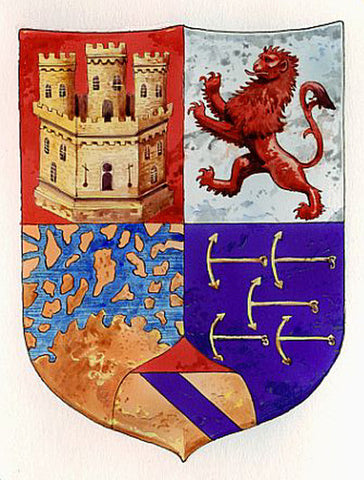Coat of Arms Augmentation part 2

 Other explorers to receive augmentations in recognition of their achievements include Vasco de Gama who received the ancient Coat of Arms of Portugal as an augmentation. The Coat of Arms in question is described as Argent five escutcheons in cross Azure each charged with five plates. He was also given the crest of a demi-man dressed “a l’indienne” holding a shield of the augmented Arms and a branch of cinnamon, all to evoke his epic voyage to India and the Spice Islands. The British explorer Sir Francis Drake had been using the Coat of Arms of a different family in Devonshire when the head of that family complained to Queen Elizabeth I, referring to Drake as an upstart. The Queen’s retort was that she would grant Sir Francis Drake a Coat of Arms that would far outshine those of his namesake. The Arms duly granted Sable a fess wavy between two estoiles ( stars) irradiated Argent very neatly summarize his voyages between the North and South Poles. The Crest above the Arms was never meant to be worn above a helmet and was so fanciful as to be drawn only. Various depictions of the Crest show a ship on top of a globe being guided by a hand emerging from the clouds, holding a golden cord; above the clouds a scroll bearing the motto: Auxilio divino (“By Divine aid”). The blazon, or description, of the Crest also includes a red dragon on the ship looking up at the hand emerging from the clouds. The motto below the Arms reads Sic parvis magna ("Greatness from small beginnings")
Other explorers to receive augmentations in recognition of their achievements include Vasco de Gama who received the ancient Coat of Arms of Portugal as an augmentation. The Coat of Arms in question is described as Argent five escutcheons in cross Azure each charged with five plates. He was also given the crest of a demi-man dressed “a l’indienne” holding a shield of the augmented Arms and a branch of cinnamon, all to evoke his epic voyage to India and the Spice Islands. The British explorer Sir Francis Drake had been using the Coat of Arms of a different family in Devonshire when the head of that family complained to Queen Elizabeth I, referring to Drake as an upstart. The Queen’s retort was that she would grant Sir Francis Drake a Coat of Arms that would far outshine those of his namesake. The Arms duly granted Sable a fess wavy between two estoiles ( stars) irradiated Argent very neatly summarize his voyages between the North and South Poles. The Crest above the Arms was never meant to be worn above a helmet and was so fanciful as to be drawn only. Various depictions of the Crest show a ship on top of a globe being guided by a hand emerging from the clouds, holding a golden cord; above the clouds a scroll bearing the motto: Auxilio divino (“By Divine aid”). The blazon, or description, of the Crest also includes a red dragon on the ship looking up at the hand emerging from the clouds. The motto below the Arms reads Sic parvis magna ("Greatness from small beginnings").











